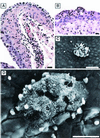Bad bugs and beleaguered bladders: interplay between uropathogenic Escherichia coli and innate host defenses
- PMID: 10922042
- PMCID: PMC34019
- DOI: 10.1073/pnas.97.16.8829
Bad bugs and beleaguered bladders: interplay between uropathogenic Escherichia coli and innate host defenses
Abstract
Strains of uropathogenic Escherichia coli (UPEC) are the causative agents in the vast majority of all urinary tract infections. Upon entering the urinary tract, UPEC strains face a formidable array of host defenses, including the flow of urine and a panoply of antimicrobial factors. To gain an initial foothold within the bladder, most UPEC strains encode filamentous surface adhesive organelles called type 1 pili that can mediate bacterial attachment to, and invasion of, bladder epithelial cells. Invasion provides UPEC with a protective environment in which bacteria can either replicate or persist in a quiescent state. Infection with type 1-piliated E. coli can trigger a number of host responses, including cytokine production, inflammation, and the exfoliation of infected bladder epithelial cells. Despite numerous host defenses and even antibiotic treatments that can effectively sterilize the urine, recent studies demonstrate that uropathogens can persist within the bladder tissue. These bacteria may serve as a reservoir for recurrent infections, a common problem affecting millions each year.
Figures








Similar articles
-
Establishment of a persistent Escherichia coli reservoir during the acute phase of a bladder infection.Infect Immun. 2001 Jul;69(7):4572-9. doi: 10.1128/IAI.69.7.4572-4579.2001. Infect Immun. 2001. PMID: 11402001 Free PMC article.
-
Dynamic interactions between host and pathogen during acute urinary tract infections.Urology. 2001 Jun;57(6 Suppl 1):56-61. doi: 10.1016/s0090-4295(01)01130-x. Urology. 2001. PMID: 11378051 Review.
-
Induction and evasion of host defenses by type 1-piliated uropathogenic Escherichia coli.Science. 1998 Nov 20;282(5393):1494-7. doi: 10.1126/science.282.5393.1494. Science. 1998. PMID: 9822381
-
Plant phenolics inhibit focal adhesion kinase and suppress host cell invasion by uropathogenic Escherichia coli.Infect Immun. 2024 May 7;92(5):e0008024. doi: 10.1128/iai.00080-24. Epub 2024 Mar 27. Infect Immun. 2024. PMID: 38534100 Free PMC article.
-
Covert operations of uropathogenic Escherichia coli within the urinary tract.Traffic. 2005 Jan;6(1):18-31. doi: 10.1111/j.1600-0854.2004.00251.x. Traffic. 2005. PMID: 15569242 Free PMC article. Review.
Cited by
-
Role of Hypoxia Inducible Factor-1α (HIF-1α) in Innate Defense against Uropathogenic Escherichia coli Infection.PLoS Pathog. 2015 Apr 30;11(4):e1004818. doi: 10.1371/journal.ppat.1004818. eCollection 2015 Apr. PLoS Pathog. 2015. PMID: 25927232 Free PMC article.
-
In-vitro Investigation of Antibiotics Efficacy Against Uropathogenic Escherichia coli Biofilms and Antibiotic Induced Biofilm Formation at Sub-Minimum Inhibitory Concentration of Ciprofloxacin.Infect Drug Resist. 2020 Aug 12;13:2801-2810. doi: 10.2147/IDR.S258355. eCollection 2020. Infect Drug Resist. 2020. PMID: 32848429 Free PMC article.
-
Transposon mutagenesis identifies uropathogenic Escherichia coli biofilm factors.J Bacteriol. 2012 Nov;194(22):6195-205. doi: 10.1128/JB.01012-12. Epub 2012 Sep 14. J Bacteriol. 2012. PMID: 22984258 Free PMC article.
-
Host response to probiotics determined by nutritional status of rotavirus-infected neonatal mice.J Pediatr Gastroenterol Nutr. 2012 Sep;55(3):299-307. doi: 10.1097/MPG.0b013e31824d2548. J Pediatr Gastroenterol Nutr. 2012. PMID: 22343914 Free PMC article.
-
Macrophages rapidly transfer pathogens from lipid raft vacuoles to autophagosomes.Autophagy. 2005 Apr;1(1):53-8. doi: 10.4161/auto.1.1.1589. Epub 2005 Apr 4. Autophagy. 2005. PMID: 16874021 Free PMC article.
References
-
- Hooton T M, Stamm W E. Infect Dis Clin North Am. 1997;11:551–581. - PubMed
-
- Svanborg C, Godaly G. Infect Dis Clin North Am. 1997;11:513–529. - PubMed
-
- Sobel J D. Infect Dis Clin North Am. 1997;11:531–549. - PubMed
-
- Hultgren S J, Jones C H, Normark S N. In: Escherichia Coli and Salmonella; Cellular and Molecular Biology. Neidhardt F C, editor. Washington, DC: Am. Soc. Microbiol.; 1996. pp. 2730–2756.
Publication types
MeSH terms
Substances
Grants and funding
LinkOut - more resources
Full Text Sources
Other Literature Sources
Medical
Research Materials

